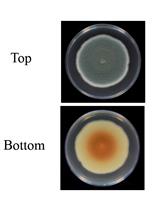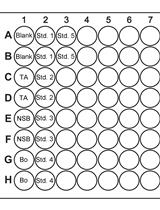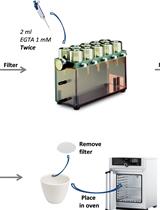- EN - English
- CN - 中文
Determination of Elemental Concentrations in Lichens Using ICP-AES/MS
ICP-AES/MS法测定地衣中元素的浓度
发布: 2017年03月05日第7卷第5期 DOI: 10.21769/BioProtoc.2165 浏览次数: 10627
评审: Dennis NürnbergChong HeAnonymous reviewer(s)
Abstract
Lichens are good biomonitors for air pollution because of their high enrichment capability of atmospheric chemical elements. To monitor atmospheric element deposition using lichens, it is important to obtain information on the multi-element concentrations in lichen thalli. Because of serious air pollution, elemental concentrations in thalli of lichens from North China (especially Inner Mongolia, Hebei, Shanxi and Henan province) are often higher than those from other regions, therefore highlighting the necessity to optimize ICP-AES/MS (Inductively coupled plasma-atomic emission spectroscopy/mass spectrometry) for analyzing lichen element content. Based on the high elemental concentrations in the lichen samples, and the differences in the sensitivity and detection limits between ICP-MS and ICP-AES, we propose a protocol for analyzing 31 elements in lichens using ICP-AES/MS. Twenty-two elements (Cd, Ce, Co, Cr, Cs, Cu, K, La, Mo, Na, Ni, Pb, Rb, Sb, Sc, Sm, Sr, Tb, Th, Tl, V and Zn) can be identified by using microwave digestion- ICP-MS, and 9 elements (Al, Ba, Ca, Fe, Mg, Mn, P, S and Ti) by using ashing-alkali fusion digestion- ICP-AES.
Keywords: Element content (元素含量)Background
Lichens have been widely used in biomonitoring of air pollution in many regions of the world, including China that experiences heavy-metal atmospheric pollution in some areas. Recent studies found that the element concentrations in lichens from North China are higher than or at the upper range of the literature values from other regions (Liu et al., 2016a; 2016b and 2016c), due to the severe air pollution in this region.
Compared with other techniques (for example spectrophotometric methods, atomic absorption spectrometry and atomic fluorescence spectrometry), ICP-AES/MS is a multi-element analysis method involving simple procedure with relatively low detection limits. This method is widely used in the quantitative analysis of lichen elements outside China. However, to date, there have been no reports on the application of ICP-AES/MS to analyze elements in lichens of North China. Specific procedures for the sample preparation of the lichens are required due to the high loadings of elements with great variation in concentration. Therefore, to facilitate the biomonitoring of atmospheric elemental deposition with lichens in China, we propose a protocol for lichen elemental concentration analyses using ICP-AES/MS.
Materials and Reagents
- Paper bags
- 10 mesh nylon standard inspection sieve (pore size 2 mm) (Shangyu Huafeng Hardware Instrument)
- 50 ml plastic centrifuge tube (SARSTEDT, catalog number: 62.559.001 )
- National certified reference materials: GBW10010 (rice), GBW10014 (cabbage) and GBW10015 (spinach; All materials mentioned above were provided by the Institute of Geophysical and Geochemical Exploration, Chinese Academy of Geological Sciences). Lichen material IAEA-336 (International Atomic Energy Agency)
- Lichens: Xanthoria mandschurica and Xanthoparmelia mexicana, collected from Taihang Mountains, Hebei Province, China
- H2O2, > 30% (w/v) (Beijing Institute of Chemical Reagents, catalog number: 160215 )
- 103Rh: 1.00 mg/ml (GSB-G62037-90, National Analysis Center for Iron & Steel, Beijing, China)
- HCl, 35-37% (w/v) (Beijing Institute of Chemical Reagents, catalog number: 160718 )
- Standard stocking solutions: 1.00 mg/ml Al (GBW[E]086219), Ba (GBW[E]080243), Ca (GBW[E]080261), Cd (GBW08612), Ce (GSB04-1775), Co (GBW08613), Cr (G130008614), Cs (GSB04-1724), Cu (GSB04-1725), Fe (GBW08616), K (GBW[E]080125), La (GBW08651), Mg (GBW[E]080126), Mn (GSB04-1736), Mo (GBW[E]080218), Na (GBW[E]080127), Ni (GBW08618), P (GBW[E]080186), Pb (GBW08619), Rb (GSB04-2836), S (GBW[E]080266), Sb (GBW[E]080545), Sc (GBW[E]3141), Sm (GSB64-1778), Sr (GSB04-1754), Tb (GSB04-1781), Th (GBW[E]080174), Ti (GBW3041), Tl (GSBG62070-90), V (GBW[E]080243), and Zn (GBW[E]080607) (National Research Center for standard materials, Beijing, China)
- Standard intermediate solutions (see Recipes; Table 8)
- Standard working solutions (see Recipes; Table 8)
Equipment
- Inductively coupled plasma mass spectrometer (ICP-MS) (Agilent Technologies, model: Agilent 7700X ICP-MS )
- Inductively coupled plasma optical emission spectrometer (ICP-AES) (Varian, model: Varian Vista MPX )
- Microwave digestion system (equipped with Teflon digestion vessels) (CEM Corporation, Matthews, model: MARS X-press )
- Grinding mill equipped with Tungsten Carbide jars (Retsch, model: Retsch MM400 )
- Stereo microscope (Motic, model: Motic SMZ-140 )
- Muffle furnace (Yiheng, model: SX2-4-10TP )
- Oven (50-120 °C)
- Tweezers
- 50 ml volumetric flask
- 30 ml nickel crucible (Jiangsu Plaza Premium Electric Instrument, catalog number: 30 ml crucible )
- Deionized water: resistivity ≥ 18.0 MΩ cm (Aquapro International, model: Aquaplore3 )
Procedure
文章信息
版权信息
© 2017 The Authors; exclusive licensee Bio-protocol LLC.
如何引用
Zhao, L., Wang, L., Jiang, Y., Hu, Y., Xu, C., Wang, L., Li, X., Wei, L., Guo, X., Liu, A. and Liu, H. (2017). Determination of Elemental Concentrations in Lichens Using ICP-AES/MS. Bio-protocol 7(5): e2165. DOI: 10.21769/BioProtoc.2165.
分类
微生物学 > 微生物生物化学 > 其它化合物
生物化学 > 其它化合物 > 元素
您对这篇实验方法有问题吗?
在此处发布您的问题,我们将邀请本文作者来回答。同时,我们会将您的问题发布到Bio-protocol Exchange,以便寻求社区成员的帮助。
提问指南
+ 问题描述
写下详细的问题描述,包括所有有助于他人回答您问题的信息(例如实验过程、条件和相关图像等)。
Share
Bluesky
X
Copy link




















